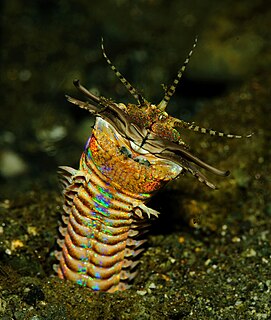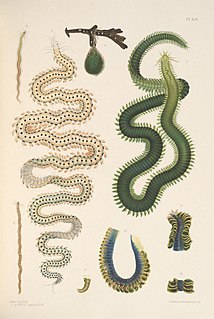| Onuphidae | |
|---|---|
 | |
| Australonuphis | |
| Scientific classification | |
| Kingdom: | Animalia |
| Phylum: | Annelida |
| Class: | Polychaeta |
| Order: | Eunicida |
| Family: | Onuphidae Kinberg, 1865 [1] |
| Genera | |
See text | |
The Onuphidae are a family of polychaete worms.
| Onuphidae | |
|---|---|
 | |
| Australonuphis | |
| Scientific classification | |
| Kingdom: | Animalia |
| Phylum: | Annelida |
| Class: | Polychaeta |
| Order: | Eunicida |
| Family: | Onuphidae Kinberg, 1865 [1] |
| Genera | |
See text | |
The Onuphidae are a family of polychaete worms.
Most onuphids have tubes. Some live semisubmerged in the substrate, but others carry their tubes around, and they can all rebuild their tubes if necessary. The tubes, thin and parchment-like, are formed of bits of shell and sand, with plant debris, stuck together with mucus. The onuphids are all omnivorous scavengers, feeding on animal and vegetable debris. [2] [3]
The prostomium has two short frontal antennae, two globular palps and five main antennae. The mandibles are large and the maxillae have several pairs of plates edged with fine teeth. Some tentacular cirri are present. The anterior parapodium points forward and has tapered ventral cirri. The posterior parapodium has cushion-like cirri. The setae include winged capillaries and pseudocompound forms on the anterior parapodia and winged capillaries, comb-setae and acicular setae on the posterior ones. [2]
The World Register of Marine Species includes these genera in the family: [1]

Nereis is a genus of polychaete worms in the family Nereididae. It comprises many species, most of which are marine. Nereis possess setae and parapodia for locomotion and gas exchange. They may have two types of setae, which are found on the parapodia. Acicular setae provide support. Locomotor setae are for crawling, and are the bristles that are visible on the exterior of the Polychaeta. They are cylindrical in shape, found not only in sandy areas, and they are adapted to burrow. They often cling to seagrass (posidonia) or other grass on rocks and sometimes gather in large groups.

Aphrodita is a genus of marine polychaete worms found in the Mediterranean sea and the eastern and western Atlantic Ocean.

Eunicidae is a family of marine polychaetes. The family comprises marine annelids distributed in diverse benthic habitats across Oceania, Europe, South America, North America, Asia and Africa. The Eunicid anatomy typically consists of a pair of appendages near the mouth (mandibles) and complex sets of muscular structures on the head (maxillae) in an eversible pharynx. One of the most conspicuous of the eunicids is the giant, dark-purple, iridescent "Bobbit worm", a bristle worm found at low tide under boulders on southern Australian shores. Its robust, muscular body can be as long as 2 m. Eunicidae jaws are known from as far back as Ordovician sediments. Cultural tradition surrounds Palola worm reproductive cycles in the South Pacific Islands. Eunicidae are economically valuable as bait in both recreational and commercial fishing. Commercial bait-farming of Eunicidae can have adverse ecological impacts. Bait-farming can deplete worm and associated fauna population numbers, damage local intertidal environments and introduce alien species to local aquatic ecosystems.

Eunicida is an order of polychaete worms.

Phyllodoce is a genus of polychaete worms, which contains about 200 species. The prostomium bears eyes, two pairs of antennae and a pair of large retractile nuchal organs. The eversible proboscis is clearly divided into two parts.

Cirratulidae is a family of marine polychaete worms. Members of the family are found worldwide, mostly living in mud or rock crevices. Most are deposit feeders, but some graze on algae or are suspension feeders.

Arenicolidae is a family of marine polychaete worms. They are commonly known as lugworms and the little coils of sand they produce are commonly seen on the beach. Arenicolids are found worldwide, mostly living in burrows in sandy substrates. Most are detritivores but some graze on algae.

Diopatra is a genus of polychaete worms in the family Onuphidae.
Acoetidae is a family of polychaete worms in the subclass Aciculata.
Ophryotrocha craigsmithi is a species of polychaete worm. O. craigsmithi is named after Craig R. Smith. This species is similar to Palpiphitime lipovskyae and O. Platykephale, among others, in having branchial structures dorsally and ventrally. It differs from O. platykephale in the shape of its prostomium and parapodia. Palpiphitime lipovskyae has jaws of both P- and K-type, while no specimens of O. craigsmithi have been found with K-type jaws thus far. Ophryotrocha craigsmithi differs from P. lipovskyae genetically, but also by the presence of a prominent ventral chaetal lobe with a bulging simple chaeta in the former.

Phyllodocidae is a family of polychaete worms. Worms in this family live on the seabed and may burrow under the sediment.

Eulalia is a genus of polychaete worms.
Eulalia clavigera is a species of polychaete worm in the family Phyllodocidae, native to the coasts around Britain, through Western France, and to the Iberian Peninsula. It closely resembles Eulalia viridis, and there has been confusion in the past as to the identification of the two species.

Leucia nivea is a species of polychaete worm, commonly known as a "scale worm", in the family Polynoidae. This species occurs in the northeastern Atlantic Ocean, the North Sea and the Mediterranean Sea.
Eunoe assimilis Eunoe assimilis is a scale worm described from Southwest of Cape Town, South Africa.
Antipathipolyeunoa is a genus of marine annelids in the family Polynoidae. The genus contains a single species, Antipathipolyeunoa nuttingi, found in the Caribbean Sea at a depth of 91 metres.
Bylgides is a genus of marine annelids in the family Polynoidae. The genus contains 9 species, all found in the Northern Hemisphere and from shallow inshore waters to depths of about 5000 m.
Eucranta is a genus of marine annelids in the family Polynoidae. The genus includes 5 species which are globally distributed from depths of about 40 to 600 m, mostly from high latitudes in the northern and southern hemispheres.
Ysideria is a genus of marine polychaete worms belonging to the family Polynoidae, the scale worms. Ysideria contains a single species, Ysideria hastata which is known from the North Pacific Ocean off the coast of California at depths of about 50–60 m.

Onuphis is a genus of polychaete belonging to the family Onuphidae.
| Wikimedia Commons has media related to Onuphidae . |